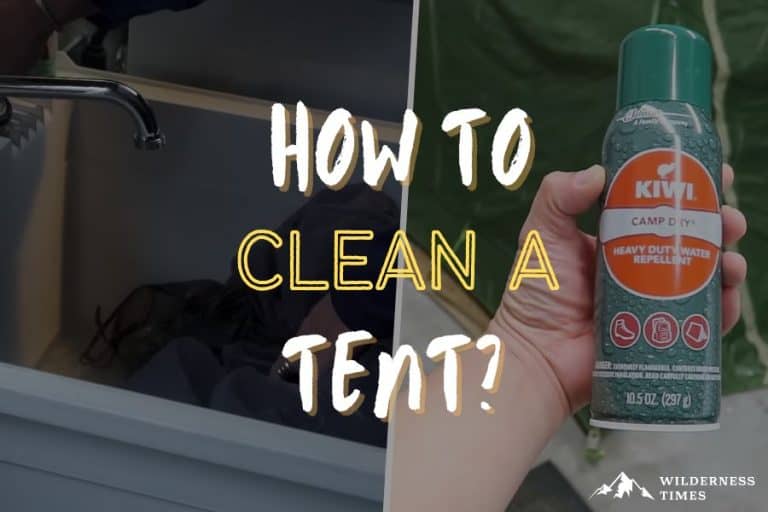When you’re out in the wild, messes can happen!
Sometimes, the sign of a great camping trip is sand in the corners of your tent and dirt on the sides.
However, too much grime, dirt, and sand can damage your tent’s fabric and equipment, ultimately decreasing its lifespan.
So, it’s always best to deep clean especially dirty tents before storing them.
Table of Contents
ToggleHow To Deep Clean A Tent: Step-By-Step
Pre-Cleaning Tips
Before you roll up your sleeves and get washing, it’s important to get a good handle on the care your tent both needs and can withstand.
First, take a good look at your tent. Do you see large stains? Is your nose picking up on any bad smells?
Assessing your tent’s condition before washing will help you understand exactly how extensive the cleaning process needs to be.
Next, make sure you read the manufacturer’s cleaning instructions.
Some tents are more particular when it comes to cleaning and will have specific instructions.
It’s important that you follow these instructions so you don’t damage your tent.
However, most tents will benefit from the same, simple cleaning process we’ve described below.
The cleaning supplies for this process include:
- A large tub or basin
- Non-detergent soap (or tent-specific cleaning solution)
- A soft sponge or cloth
- A soft brush
- A clean, dry towel
Step 1: Removing Dirt & Debris
Before you get your tent wet, make sure you brush off any dry dirt or debris on the outside of the tent.
You can do this by shaking out your tent, or by brushing off dirt by hand.
Don’t worry too much about being perfect here. All we’re trying to do on this step is remove excess dirt and dust.
Any remaining stains will be brushed more extensively later in the process.
Step 2: Preparing The Cleaning Solution
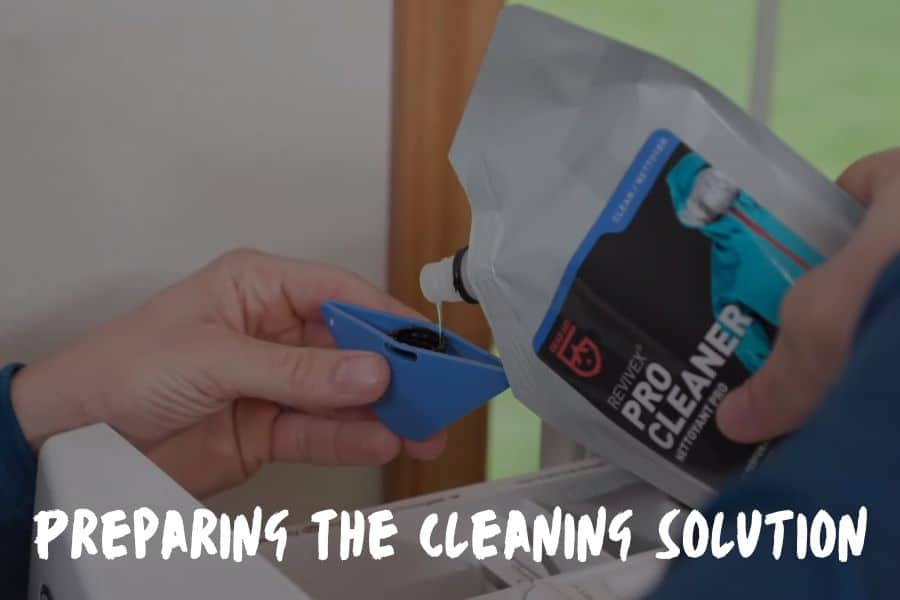
Next, you’ll want to fill your tub with cool to lukewarm water and soap.
It’s important to use a non-detergent soap or cleaner for this process to ensure your tent materials are well taken care of.
More intense cleaning supplies can strip the water resistance fabric coatings off your tent and leave you vulnerable to rain or moisture on your next trip.
I recommend using a neutral castile soap, like Dr. Bronner’s, or a gentle, unscented dish soap.
You can also use a “tech wash,” which has been designed to wash tent fabrics without stripping its coatings.
Examples of tech washes include Gear Aid ® Revivex or Nikwax Tech Wash.
Before adding these cleaning solutions to the water, make sure you take a look at their instructions and follow any soap-to-water ratios that they recommend.
This, as well as the dirt level on your tent materials, will guide how much soap you’ll need to add.
Step 3: Addressing Tough Stains & Marks
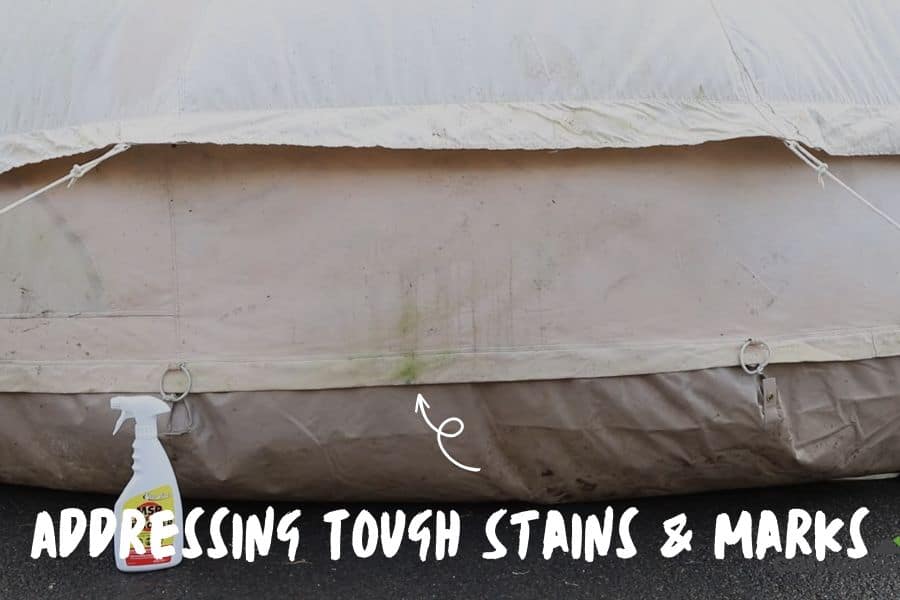
Before you add the entire tent into the cleaning solution, first tackle the problem areas of the tent.
You can use a non-abrasive sponge to spot clean dirty spots with the cleaning solution.
In addition to addressing any big stains, you can also use the sponge to clean the harder-to-reach areas during this portion, like the seams and corners of the tent.
Step 4: Handwashing The Tent
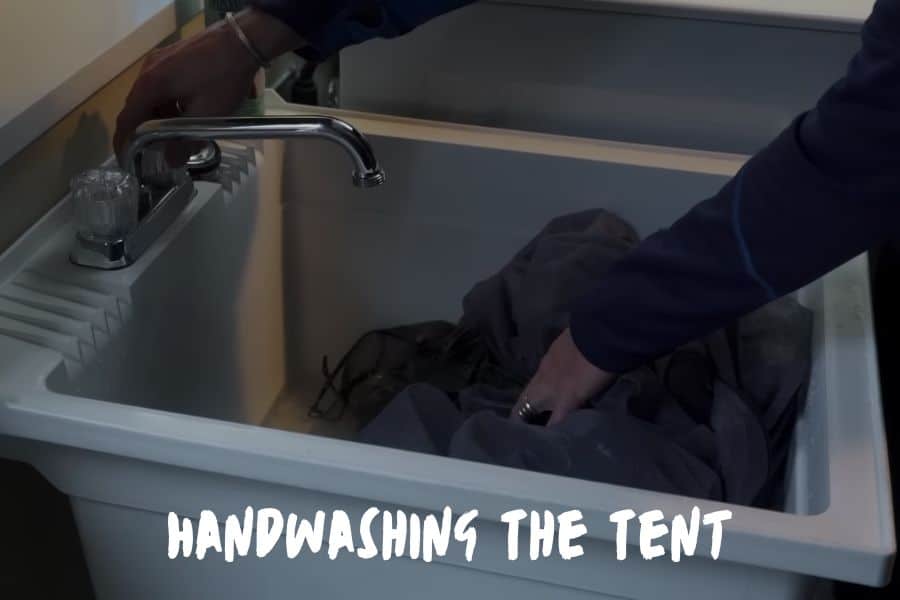
It’s time to roll up your sleeves and get cleaning!
Once you’ve addressed the problem areas, start moving the entire tent through the soapy water in a kneading motion.
You’ll want to make sure that every part of the tent has been submerged in soapy water and agitated throughout the wash.
Once you’ve completed a few “kneads”, take a look at your water.
If it’s especially dirty, replace the soiled water with fresh water and add back in the cleaning solution for another round of cleaning. Repeat as necessary.
You’ll know the tent as a whole is clean when the water is no longer getting dirty after agitating it.
Step 5: Cleaning Tent Zippers
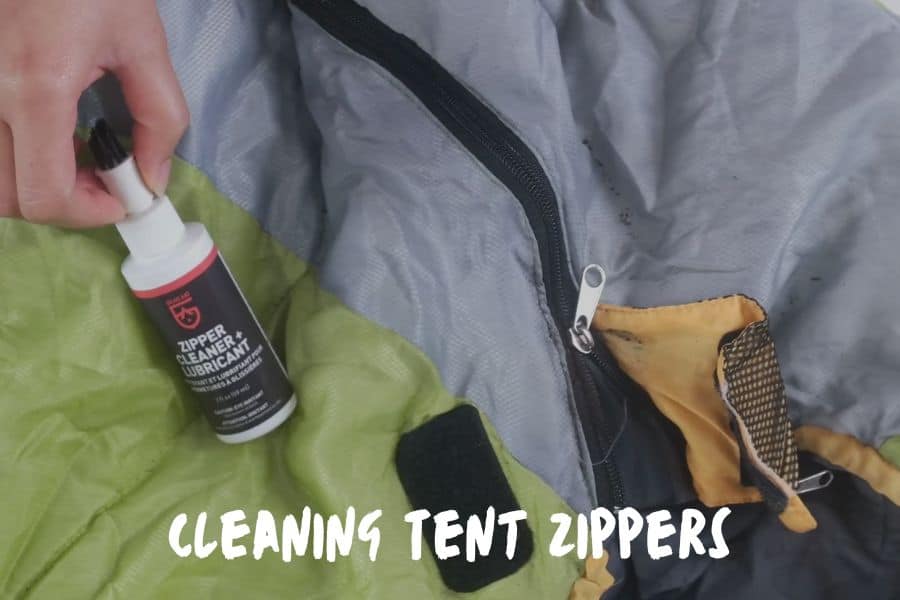
I generally save the zippers until the very last steps because I want to give them the chance to get clean on their own before going in with additional materials.
However, if your zippers are still dirty after the cleaning process we’ve discussed above, it’s time to go in with a soft brush.
For this step, I gently brush the zippers with a toothbrush and the cleaning solution to get off any remaining dirt or grime.
You can also use a soft brush for any other particularly tricky or small spots in need of a scrub (like seams or corners).
Step 6: Apply Fabric Coatings
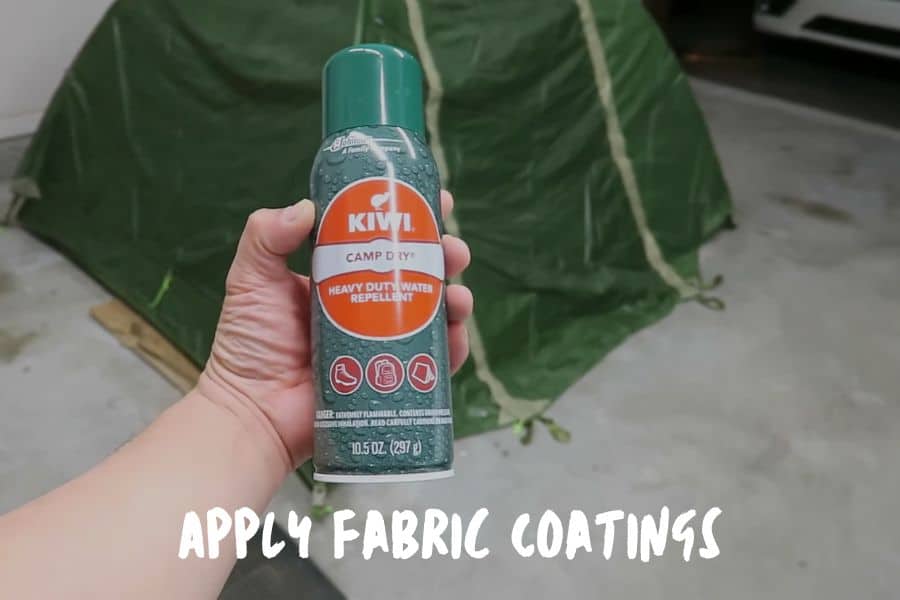
This step is optional but can be useful to complete every few cleanings.
Your tent will lose its water- and UV-resistant coatings through wear and use. It can also lose them through cleaning.
Every few years, it’s a great idea to re-apply these coatings to ensure your tent is ready to go for your next campout.
Many water-repellent coatings require the tent to be damp for the best application.
So, if you are choosing to re-apply these coatings, this is the best part of this process to complete that step.
Post-Cleaning Storage & Maintenance
The most important part about storing a tent is making sure that it is 100% dry before folding it and storing it away.
Any residual moisture will turn into mold or mildew once the tent is put up on a shelf.
When storing a tent, keep the tent itself loosely folded, rather than completely packed up (like it would be when you’re using it on a camping trip).
This will ensure that any extra moisture is able to evaporate on its own, and that the fabric doesn’t get worn down from unnecessary friction.
Lastly, make sure that you shake out and dry your tent after every single campout.
Remember: you do not need to complete a deep cleaning after every outdoor excursion, you should be getting rid of excess dirt, sand, and water before storing it away.
You should only complete a deep clean after a long (or dirty) trek, or at least once a year if the tent is being used regularly.
Resolving Common Issues
There are a few common issues you’ll likely run into when washing your tent.
We’ll review these below, as well as the best ways to combat them.
Handling Mold & Mildew In Tents
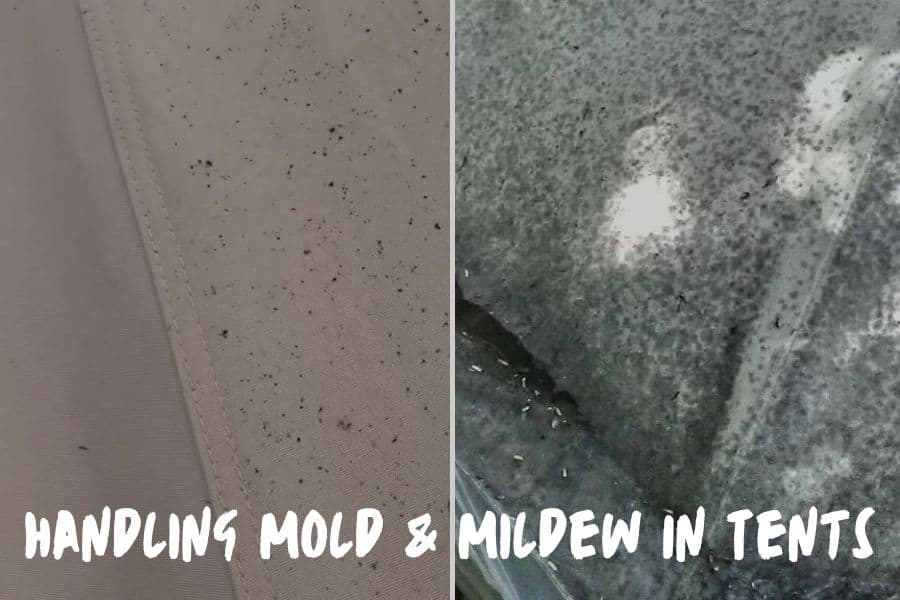
The best way to keep mold and mildew off your tent is to prevent them from ever growing in the first place!
To prevent mold, make sure your tent is 100% dry before storing it away, especially along the zippers and seems.
Sometimes, it’s impossible to get a tent totally dry before packing it up on the trail, leaving room for mold and mildew to grow before you can get home.
If this is the case for your tent, there are a few ways to get rid of the unwanted growth beyond soap and water.
Vinegar + Dish Soap
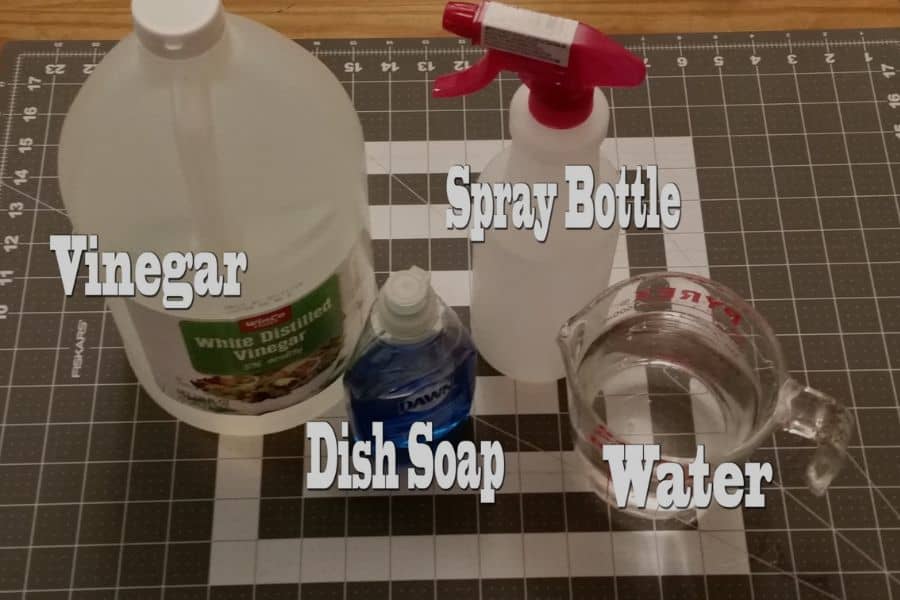
In your large tub, combine warm water and vinegar together in a 5:1 ratio.
Then add a few pumps of your non-detergent soap to the mixture.
Do not dunk the tent in this mixture! Instead, use this mixture to scrub the problem areas of your tent.
If needed, you can also use a soft scrub brush to get the especially difficult mold spots.
Be sure to completely wash off this mixture before letting the tent dry.
Lemon Juice + Salt
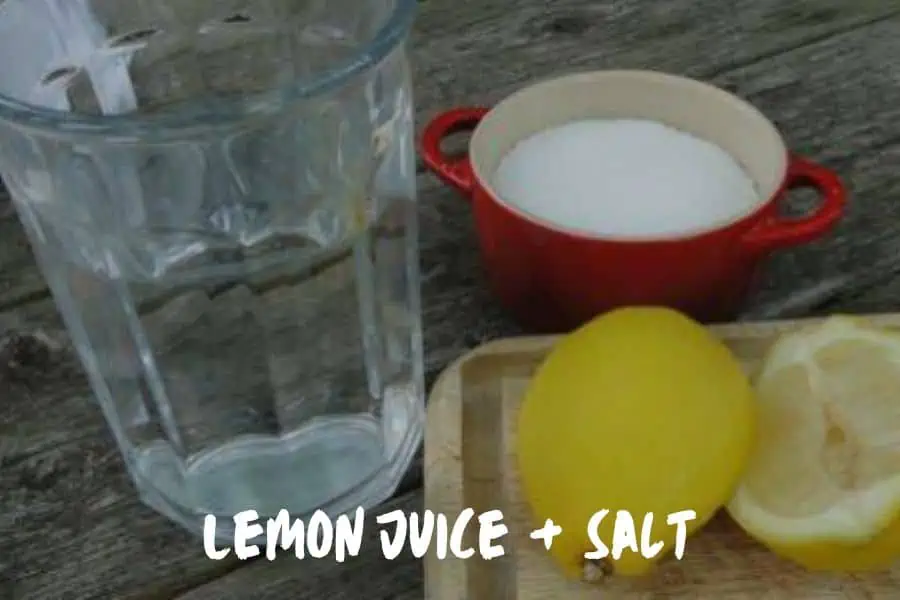
Mix equal parts lemon juice, salt, and warm water together.
Once you’ve created this mixture, you can use it as a scrubbing solution for the mold and mildew spots on your tent.
Here again, you can use a scrubbing brush if you need to tackle especially difficult spots.
Make sure to completely wash off this mixture before you set the tent out to dry.
Dealing With Odors In The Tent
Just like with mold, prevention is the best way to prevent your tent from getting any bad odors.
However, if you complete our cleaning process detailed above and your tent is still smelly, it’s time for extra measures.
I recommend using the same mixtures detailed above for mold removal.
However, this time you’re going to submerge the entire smelly tent structure into the mixture, rather than using the mixture to spot clean.
Once you’ve submerged the tent, use the “kneading” motion described above to wash the entire tent in the mixture.
Even though it’s tempting, avoid using scented soaps or any cleaning product with a fragrance during tent cleaning.
Any unusual fragrances can attract bugs and critters to your tent the next time you’re out on the trail.
Removing Pine Sap Or Other Sticky Substances
The first way to get rid of sap is to make sure it never gets on your tent!
While you’re out on the trail, I recommend you lay down a ground tarp to protect the bottom of your tent from the ground… and potential sap spots!
Sap can be tricky to remove by hand without damaging your tent materials.
If you see any sap solidified on your tent, wait until you get home (or until you have the correct cleaning materials) to remove it.
First, I recommend that you use dish soap to spot clean the sticky spots.
If this doesn’t work, you can dab small portions of mineral oil on the spot until the sap comes loose.
FAQs
What Are Some Environmentally Friendly Options For Cleaning A Tent?
If it’s important for you to use environmentally friendly cleaning products when cleaning your tent, you’re in luck!
There are multiple products that are low-impact and biodegradable that you can use in your cleaning solution.
Examples include: Dr. Bronner’s, Wilderness Wash, or CampSuds.
Can I Use Household Products To Clean My Tent, Or Do I Need Specialized Camping Equipment Cleaners?
You can absolutely use household products to clean your tent. I generally use either Dr. Bronner’s or gentle dish soap for my cleaning solution.
Both of these options can usually be found in your home or in your neighborhood grocery store.
Specialized products are also available for cleaning your tent.
These products are made to be strong cleaners while also not damaging any coatings applied to the outside of your tent materials.
Examples include: MiraZyme, Gear Aid ® Revivex, or Nathan® Sport Wash.
What Should I Do If My Tent Has Sustained Damage, Like Tears Or Broken Zippers, During My Camping Trip?
There are multiple ways to repair tents during camping trips. When I’m on the trail, I generally have duct tape or climbing tape with me to patch up tears or rips that happen onsite.
If you have one that’s light enough, you can even bring a sewing kit with you to sew up broken seals or larger rips.
However, I generally leave mine at home and use it when I get back to avoid the added weight in my pack.
When you get back from your trip, you can take even more extensive measures, like taking your tent to a repair shop or spending a few hours using your sewing kit on it.
How Can I Clean My Tent On A Multi-Day Camping Trip, Especially When I Don’t Have Access To A Lot Of Water?
It’s best to wait until you get home from your camping trip to do a deep clean of your whole tent.
However, while you’re on the trail you can spot clean by using a cloth and water to wipe away any grime, like bird feces or mud splatters, that may fall on your tent.
Is It Possible To Clean A Tent In A Washing Machine Or Should It Always Be Hand Washed?
NEVER wash your tent in a washing machine! Putting your beloved tent through the spin cycle can overheat and stretch the fabric.
In addition, the heat from washing machines can ruin any water or UV-resistant fabric coatings on your tent.
These coatings keep you dry on a camping trip. In other words, you don’t want to leave home without them!
To prevent any damage to your tent, make sure you only wash it by hand.
How Do I Clean A Smelly Tent?
There are a few options when it comes to cleaning a smelly tent. You can use either a mixture of vinegar and water, or a mixture of lemon, salt, and water.
For more details, read the “Resolving Common Issues” section above.
Once you’ve made your preferred cleaning mixture, you’ll submerge the tent, rinse, and repeat until there’s no more smell!
In Conclusion
Cleaning your tent is one of the important steps in making sure your tent goes the distance for years to come.
When in doubt, use the step-by-step process we’ve detailed above to get that tent squeaky clean!
More on Cleaning Gear:


